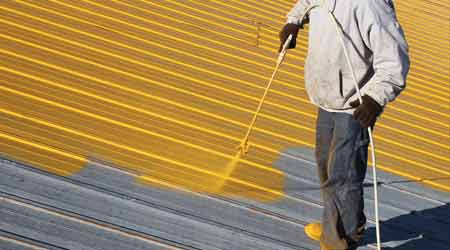What Type of Roof Coating is Best
Part two of a three part series on roof coatings
Which one?
Once a manager has decided to specify a roof coating, the next question is, which coating is most appropriate for the application? Several types of roof coatings offer a range of benefits to a facility, and in recent years the formulation of roof coatings has evolved. For these reasons, managers need to consider several issues related to performance and materials before making a final decision.
“There have been a number of changes that are allowing the market to rely and call on these kinds of products much more than we have in the past,” says Keith Borden with Tropical Roofing Products. “I think with newer technologies, easier applications, less labor and being less disruptive on the overall performance of the business, roof coatings are more popular than ever.”
Managers looking to address specific roofing issues can focus on developments in three areas — silicone content, reflectivity and sustainability.
Silicones are the newest options in roof coatings Baumann says.
“Developed earlier this century are the high-solids, 100 percent silicone coating systems,” she says, adding that they “typically contain solids in excess of 95 percent, and they contain no water and no solvents. This means they are a condensation curer.”
As the coating absorbs atmospheric moisture, it begins to transform from the liquid coating into the seamless, monolithic system that protects roofs, she says. Compared to low-solvent silicone coatings, which contain 30-40 percent solvents, the new formulation often is a higher-quality product.
Silicone roof coatings tend to last longer than other coating materials, perform better and extend the life of a roofing system, says Josh McKain with Progressive Roofing.
When specifying roof coatings, manufacturers also need to carefully consider the coating’s reflectivity.
“If you’re in a roofing area where you have more cooling days than heating days, it may be more advantageous to have a highly reflective roof,” Baumann says. “By having a white surface, the sun’s rays hit that surface get reflected off and back up into the environment instead of being absorbed into the roofing system.”
By specifying coatings with higher reflectivity and emissivity ratings, managers can keep buildings cooler and energy costs down because the cooling system is not running as often or as long.
As with most other products going into and onto facilities, roof coatings also have come under greater scrutiny in terms of their sustainability.
“There has been a big push for materials to be environmentally conscious while still maintaining properties that both building owners need or want,” Carlin says. “Building owners want a roof that has solid performance, withstands the effects of weather, assists them in saving money, and in some instances, looks visually appealing.”
Today’s coatings make it easier for managers to find the balance between sustainability and performance. By removing volatile organic compounds (VOCs) from new-generation roof coatings, manufacturers have addressed odor concerns of both technicians applying coatings and building occupants.
Solventless coatings offer a safer solution by minimizing the VOCs and, in some cases, eliminating them completely.
Managers “can now have products that are extremely low in VOCs, if not zero, that are very environmentally friendly,” Borden says. “There are no odors associated with the coatings, and that can eliminate hazardous conditions for applications. There are solventless products that perform exceptionally well.”
Applications of roof coatings also address sustainability considerations because they can save managers from having to fully replace a roof.
“They not only save a facility money,” Carlin says. “They can save the environment by not adding more to our landfills.”
Related Topics:














